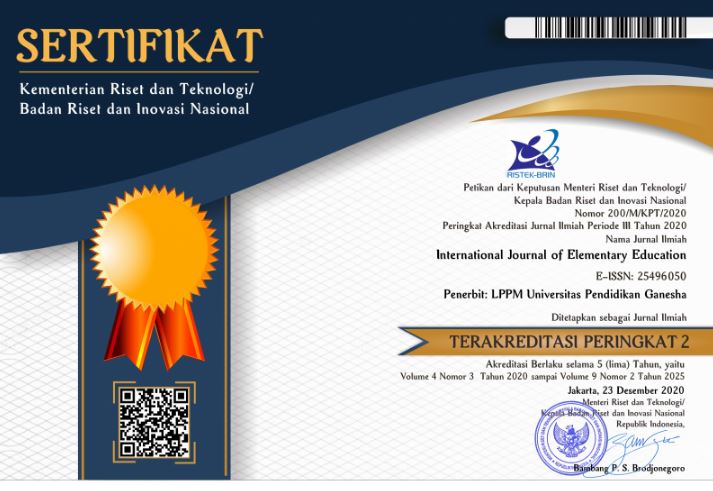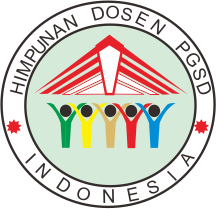Enhancing Early Reading Skills Through Literacy Alphabet Cards: An Innovative Solution for Elementary Students
DOI:
https://doi.org/10.23887/ijee.v8i3.84610Keywords:
Early Reading Skills, Literacy Alphabet Cards, Learning MediaAbstract
The issue of low early reading proficiency among students is the primary focus of this study. This research aims to analyze the factors influencing students' reading difficulties, describe the implementation of the Literacy Alphabet Cards (KAL) as a learning medium in early-grade classrooms, and present the outcomes of its application in teaching. A qualitative research method with a descriptive design was employed. Data collection techniques included observations, interviews, and the direct involvement of the researcher in the learning process. Data were analyzed using an interactive data analysis technique encompassing data collection, data reduction, data presentation, and conclusion drawing with verification. The findings reveal internal factors affecting reading difficulties, such as intelligence levels and learning motivation, as well as external factors, including family and community environments. The KAL medium was designed using simple materials and implemented directly during the teaching process. The application of the KAL medium proved effective in enhancing early reading skills, as evidenced by improvements in students’ learning outcomes. The study concludes that the KAL medium can serve as an innovative alternative to addressing early reading difficulties by incorporating approaches that consider both internal and external student factors.
References
Amirullah, A., Putra, A. T. A., & Kahar, A. A. D. A. (2020). Deskripsi Status Gizi Anak Usia 3 Sampai 5 Tahun pada Masa Covid-19. Murhum: Jurnal Pendidikan Anak Usia Dini, 1(1), 16–27.
Amri, C., & Kuniawan, D. (2023). Strategi Belajar dan Pembelajaran dalam Meningkatkan Keterampilan Bahasa. Journal of Student Research, 1(1), 202–214. https://doi.org/10.55606/jsr.v1i1.980.
Antara, I. G. W. S., Suma, K., & Parmiti, D. P. (2022). E-Scrapbook: Konstruksi Media Pembelajaran Digital Bermuatan Soal-soal Higher Order Thinking Skills. Jurnal Edutech Undiksha, 10(1), 11–20. https://doi.org/10.23887/jeu.v10i1.47559.
Ardhani, A. D., Ilhamdi, M. L., & Istiningsih, S. (2021). Pengembangan Media Pembelajaran Berbasis Permainan Monopoli pada Pelajaran Ilmu Pengetahuan Alam (IPA) Kelas IV SD. Jurnal Pijar Mipa, 16(02), 170–175. https://doi.org/10.29303/jpm.v16i2.2446.
Asikin, N., Nevrita, N., & Alpindo, O. (2019). Pelatihan pemanfaatan media pembelajaran berbasis virtual reality untuk guru-guru IPA kota Tanjungpinang. Jurnal Anugerah, 1(2), 71–76. https://doi.org/10.31629/anugerah.v1i2.1606.
Azizah, S. N., & Rahmawati, F. P. (2022). Implementeasi Inovasi Keterampilan Membaca Permulaan Melalui Media Kartu Huruf Terintegrasi Poster Bergambar Bagi Kelas I Sekolah Dasar. Jurnal Basicedu, 6(4), 6241–6247. https://doi.org/10.31004/basicedu.v6i4.3214.
Cindrakasih, R. (2020). Efektivitas pembelajaran daring menggunakan media online selama pandemi covid-19 pada mata kuliah Pik dalam pandangan mahasiswa (Vol. 1, Issue 1, pp. 39–44). https://doi.org/10.31294/jpr.v1i1.165.
Daryanes, F., Darmadi, D., Fikri, K., Sayuti, I., Rusandi, M. A., & Situmorang, D. D. B. (2023). The development of articulate storyline interactive learning media based on case methods to train student’s problem-solving ability. Heliyon, 9(4), 15082. https://doi.org/10.1016/j.heliyon.2023.e15082.
Dwiqi, G. C. S., Sudatha, I. G. W., & Sukmana, A. I. W. I. Y. (2020). Pengembangan Multimedia Pembelajaran Interaktif Mata Pelajaran IPA Untuk Siswa SD Kelas V. Jurnal Edutech Undiksha, 8(2), 33. https://doi.org/10.23887/jeu.v8i2.28934.
Fitriyah, C. Z., & Wardani, R. P. (2022). Paradigma Kurikulum Merdeka Bagi Guru Sekolah Dasar. Scholaria: Jurnal Pendidikan Dan Kebudayaan, 12(3), 236–243. https://doi.org/10.24246/j.js.2022.v12.i3.p236-243.
Kazi, S., Kazali, E., Makris, N., Spanoudis, G., & Demetriou, A. (2019). Cognizance in cognitive development: A longitudinal study. Cognitive Development, 52. https://doi.org/10.1016/j.cogdev.2019.100805.
Madu, F. J., & Jediut, M. (2022). Membentuk Literasi Membaca Pada Peserta Didik Di Sekolah Dasar. Jurnal Cakrawala Pendas, 8(3), 631–647. https://doi.org/10.31949/jcp.v8i3.2436.
Marcela, R., Idris, M., & Aryaningrum, K. (2022). Pengembangan media permainan ular tangga dalam pembelajaran IPS Siswa Kelas IV SD Negeri 138 Palembang. Journal on Teacher Education, 4(1), 54–61. https://doi.org/10.31004/jote.v4i1.5680.
Mowata, Y. A., Molina, J. I., & Loban, J. M. (2023). Pendampingan Belajar Untuk Peningkatan Numerasi di SMP Kristen 03 Kalabahi dalam Masa Penugasan Mahasiswa Program Kampus Mengajar Angkatan IV. ABDIKAN: Jurnal Pengabdian Masyarakat Bidang Sains Dan Teknologi, 2(1), 83–89. https://doi.org/10.55123/abdikan.v2i1.1681.
Muhtar, M. A., Hastutik, S., Evana, Z., & Sufanti, M. (2021). Gerakan Literasi Membaca Sebagai Penumbuh Kreativitas Siswa di SMP Negeri 1 Simo. Buletin Literasi Budaya Sekolah, 4(2), 61–67. https://doi.org/10.23917/blbs.v4i2.14450.
Mulyati, S., & Evendi, H. (2020). Pembelajaran Matematika Melalui Media Game Quizizz Untuk Meningkatkan Hasil Belajar Matematika SMP. Jurnal Pendidikan Matematika, 3(1), 64–73. https://doi.org/10.30656/gauss.v3i1.2127.
Muthoharoh, M. (2019). Media powerpoint dalam pembelajaran. Tasyri: Jurnal Tarbiyah-Syariah-Islamiyah, 26(1), 21–32. https://doi.org/10.29138/tasyri.v26i1.66.
Pramita, M., Sukmawati, R. A., Purba, H. S., Wiranda, N., Kusnendar, J., & Sajat, M. S. (2022). Student acceptance of e-learning to improve learning independence in the department of computer education. Indonesian Journal on Learning, 4(1), 34–44. https://doi.org/10.23917/ijolae.v4i1.9265.
Pranoto, Y. K. S., & Nafisah, A. D. (2022). Persepsi Anak Usia Dini Terhadap Guru Di Semarang. Bookchapter Pendidikan Universitas Negeri Semarang, 1, 150–189. https://doi.org/10.1529/kp.v1i1.40.
Renny, C. A. (2020). Management stress kerja guru sd terhadap beban kerja pada masa pandemi covid-19. Consilia: Jurnal Ilmiah Bimbingan Dan Konseling, 3(3), 219–226. https://doi.org/10.33369/consilia.3.3.219-226.
Sahronih, S., Purwanto, A., & Sumantri, M. S. (2019). The effect of interactive learning media on students’ science learning outcomes. Proceedings of the 2019 7th International Conference on Information and Education Technology, 20–24. https://doi.org/10.1145/3323771.3323797.
Salsabila, U. H., Seviarica, H. P., & Hikmah, M. N. (2020). Urgensi Penggunaan Media Audiovisual dalam Meningkatkan Motivasi Pembelajaran Daring di Sekolah Dasar. INSANIA: Jurnal Pemikiran Alternatif Kependidikan, 25(2), 284–304. https://doi.org/10.24090/insania.v25i2.4221.
Sanjani, M. A. (2020). Tugas dan Peranan Guru dalam Proses Peningkatan Belajar Mengajar. Serunai: Jurnal Ilmiah Ilmu Pendidikan, 6(1), 35–42. https://doi.org/10.37755/sjip.v6i1.287.
Sari, B. P., Helda, T., & Rahmi, A. (2023). Efektivitas Model Pembelajaran Problem Based Instruction Berbantuan Audio Visual terhadap Keterampilan Menulis Teks Anekdot. Indonesian Journal of Instruction, 4(1), 1–9. https://doi.org/10.23887/iji.v4i1.44565.
Suharni, S. (2021). Upaya guru dalam meningkatkan motivasi belajar siswa. G-Couns: Jurnal Bimbingan Dan Konseling, 6(1), 172–184. https://journal.upy.ac.id/index.php/bk/article/view/2198/1346.
Suminar, R. K., Narimo, S., Prastiwi, Y., & Rahmawati, L. E. (2023). Reconstruction of child-friendly school through pancasila student profiles dimensions of mutual cooperation. Jurnal Ilmiah Sekolah Dasar, 7(1), 104–113. https://doi.org/10.23887/jisd.v7i1.55686.
Susanti, Y. (2020). Pembelajaran matematika dengan menggunakan media berhitung di sekolah dasar dalam meningkatkan pemahaman siswa. Edisi, 2(3), 435–448. https://ejournal.stitpn.ac.id/index.php/edisi/article/download/1122/787.
Syahputra, F., & Maksum, H. (2020). The Development of Interactive Multimedia Learning in Information and Communication Technology Subjects. Journal of Education Research and Evaluation, 4(4), 428–434. https://doi.org/10.23887/jere.v4i4.29931.
Wasito, A., Al ma’ruf, A. I., & Rahmawati, L. E. (2022). Utilization of visual media in thematic learning in elementary schools. Jurnal Ilmiah Sekolah Dasar, 6(4), 584–591. https://doi.org/10.23887/jisd.v6i4.53744.
Widjayanti, W. R., Masfingatin, T., & Setyansah, R. K. (2019). Media Pembelajaran Interaktif Berbasis Animasi pada Materi Statistika untuk Siswa Kelas 7 SMP. Jurnal Pendidikan Matematika, 13(1), 101–112. https://doi.org/10.22342/jpm.13.1.6294.101-112.
Wirabumi, R. (2020). Metode pembelajaran ceramah. Annual Conference on Islamic Education and Thought (ACIET, 1(1), 105–113. https://pkm.uika-bogor.ac.id/index.php/aciet/article/view/660.
Wirman, A., Yaswinda, Y., & Tanjung, A. (2018). Pengunaan Media Moving Flahscard Untuk Stimulasi Kemampuan Literasi Anak Usia Dini. Early Childhood: Jurnal Pendidikan, 2(2b), 54–62. https://doi.org/10.35568/earlychildhood.v2i2b.290.
Wulandari, S. (2020). Media pembelajaran interaktif untuk meningkatkan minat siswa belajar matematika di smp 1 bukit sundi. Indonesian Journal of Technology, Informatics and Science (IJTIS, 1(2), 43–48. https://core.ac.uk/download/pdf/327101883.pdf.
Yudiyanto, M., Arifillah, M. J., Ramdani, P., & Masripah, I. (2022). Penerapan Permainan Ular Tangga sebagai Pembelajaran Pada Mata Pelajaran IPA. MURABBI, 1(1), 1–13. https://doi.org/10.69630/jm.v1i1.1.
Yuliandari, R. N., & Hadi, S. (2020). Implikasi Asesmen Kompetensi Minimum Dan Survei Karakter Terhadap Pengelolaan Pembelajaran SD. Ibriez: Jurnal Kependidikan Dasar Islam Berbasis Sains, 5(2), 207–223. https://ibriez.iainponorogo.ac.id/index.php/ibriez/article/view/119.
Zakaria, W., Turmudi, T., & Pentang, J. T. (2022). Information and Communication Technology in Elementary Schools: A Comparison Between Hybrid and Face-to-Face Learning Systems. Profesi Pendidikan Dasar, 9(1), 46–54. https://journals.ums.ac.id/ppd/article/view/17534.
Downloads
Published
How to Cite
Issue
Section
License
Copyright (c) 2024 Main Sufanti, Kartika Satya Noviafitri, Sabrina Khoir Rifa

This work is licensed under a Creative Commons Attribution-ShareAlike 4.0 International License.
Authors who publish with the International Journal of Elementary Education agree to the following terms:
- Authors retain copyright and grant the journal the right of first publication with the work simultaneously licensed under a Creative Commons Attribution License (CC BY-SA 4.0) that allows others to share the work with an acknowledgment of the work's authorship and initial publication in this journal.
- Authors are able to enter into separate, additional contractual arrangements for the non-exclusive distribution of the journal's published version of the work (e.g., post it to an institutional repository or publish it in a book), with an acknowledgment of its initial publication in this journal.
- Authors are permitted and encouraged to post their work online (e.g., in institutional repositories or on their website) prior to and during the submission process, as it can lead to productive exchanges, as well as earlier and greater citation of published work. (See The Effect of Open Access)








